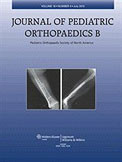Svehlík M, Zwick EB, Steinwender G, Saraph V, Linhart WE. J Pediatr Orthop B. 2010 Jul;19(4):366–72. IF: 0.660

Abstract:
The aim of the study was to confirm the hypothesis of the influence of the dynamic and fixed equinus deformity on the timing of knee recurvation (hyperextension). According to our hypothesis, dynamic equinus is linked to early and fixed equinus and to late knee hyperextension. A group 35 children with cerebral palsy (47 lower limbs) was divided into two subgroups according to the timing of maximum knee hyperextension. Clinical examination confirmed our hypothesis. Gait analysis and musculoskeletal modelling results were compared with 12 normally developing children. Both recurvatum groups had forefoot landing and neither achieved normal ankle dorsiflexion. Electromyographic examination revealed an abnormally high soleus activity in a single stance. Muscle length changes of medial gastrocnemius and soleus were in agreement with our hypothesis. Such a finding might simplify the decision as to which treatment to select for equinus deformity, present in patients with genu recurvatum.
-mk-
